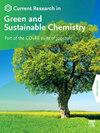由红宝石启发的 Cu-ZnO 纳米复合材料的生物合成:可见光光催化降解和抗菌评估的双重模拟
Q2 Materials Science
Current Research in Green and Sustainable Chemistry
Pub Date : 2024-01-01
DOI:10.1016/j.crgsc.2024.100435
引用次数: 0
摘要
利用茜草根提取物合成了掺铜氧化锌纳米粒子(NPs),并对其光催化降解和抗菌特性进行了评估。在所有掺杂浓度中,5% Cu-ZnO NPs 的紫外-可见光分析表明,其带隙从原始 ZnO 的 3.2 eV 减小到 2.98 eV,明显转向可见光范围。通过 XRD 和傅立叶变换红外光谱分析,可以确定形成的 NPs 为具有 ZnO 功能团的渥兹晶体结构(尺寸为 16.67 nm)。5 % Cu-ZnO NPs 对茜草红(AZ)(80 %)和罗丹明 B(RhB)(82 %)染料的光催化降解效率最高。利用响应面方法学(RSM)和自适应神经模糊推理系统(ANFIS)进行了统计建模和优化,最终开发出预测准确率达 90% 的模型。此外,生物源 Cu-ZnO 纳米粒子对革兰氏阳性(金黄色葡萄球菌)和革兰氏阴性(大肠杆菌)细菌都具有有效的抗菌特性。这种生物合成方法显示出更高的光催化效率和抗菌特性,表明其具有环境友好型应用的潜力。本文章由计算机程序翻译,如有差异,请以英文原文为准。

Rubia-inspired biogenic synthesis of Cu–ZnO nanocomposites: Dual-modelling of visible light photocatalytic degradation and antibacterial assessment
Cu-doped ZnO nanoparticles (NPs) were synthesised using Rubia cordifolia root extract and their photocatalytic degradation and antimicrobial properties were evaluated. Among all dopant concentrations, UV-VIS analysis of 5 % Cu–ZnO NPs revealed a clean shift towards the visible range with a reduction in the band gap from 3.2 eV for pristine ZnO to 2.98 eV. Formed NPs were identified as wurtzite crystal structure (size of 16.67 nm) having functional group of ZnO, using XRD and FTIR analysis. Highest photocatalytic degradation efficiencies of both Alizarine Red (AZ) (80 %) and Rhodamine B (RhB) (82 %) dyes were by 5 % Cu–ZnO NPs. Statistical modelling and optimization were conducted using Response Surface Methodology (RSM) and Adaptive Neuro-Fuzzy Inference System (ANFIS), resulting in development of models having >90 % predictive accuracy. Furthermore, the biogenic Cu–ZnO nanoparticles exhibits effective antimicrobial properties against both gram-positive (S. aureus) and gram-negative (E. coli) bacteria. The biogenic synthesis approach demonstrated enhanced photocatalytic efficiency and antimicrobial properties, suggesting its potential for environmentally friendly applications.
求助全文
通过发布文献求助,成功后即可免费获取论文全文。
去求助
来源期刊

Current Research in Green and Sustainable Chemistry
Materials Science-Materials Chemistry
CiteScore
11.20
自引率
0.00%
发文量
116
审稿时长
78 days
 求助内容:
求助内容: 应助结果提醒方式:
应助结果提醒方式:


